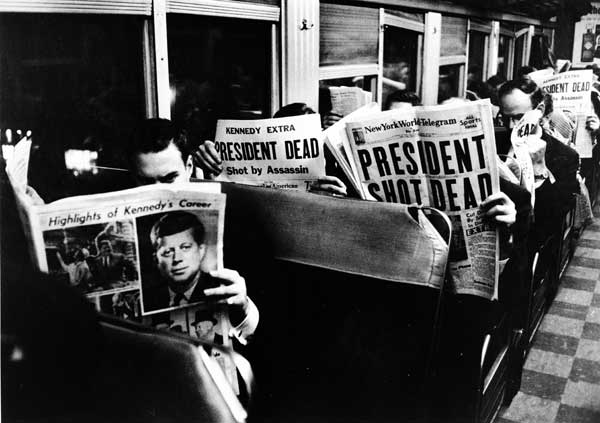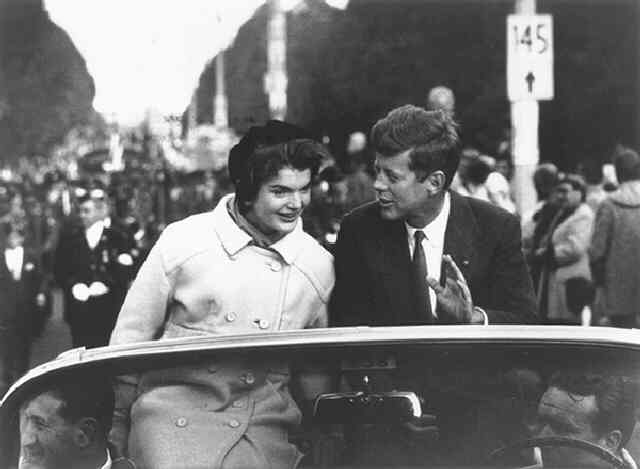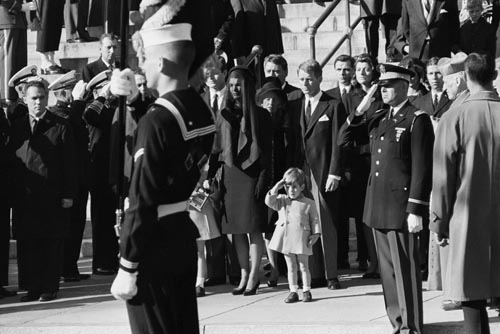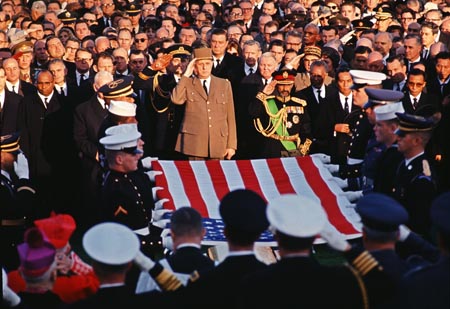November 22, 1963: Death of the President
November 22, 2010 | Source: Monroe Gallery of Photography

Carl Mydans: On the 6:25 from Grand Central to Stamford, CT, November 22, 1963
By the fall of 1963, President Kennedy and his political advisers were preparing for the next presidential campaign.

Carl Mydans: Senator John F. Kennedy Campaigning with his Wife in Boston , 1958
Although he had not formally announced his candidacy, it was clear that JFK was going to run and he seemed confident—though not over-confident— about his chances for re-election.
At the end of September, the President traveled west speaking in nine different states in less than a week. While the trip was meant to put a spotlight on natural resources and conservation efforts, JFK also used it to sound out themes -- such as education, national security, and world peace -- for his run in 1964. In particular, he cited the achievement of a limited nuclear test ban, which the Senate had just approved and which was a potential issue in the upcoming election. The public's enthusiastic response was encouraging.
A month later, the President addressed Democratic gatherings in Boston and Philadelphia. Then, on November 12, he held the first important political planning session for the upcoming election year. At the meeting, JFK stressed the importance of winning Florida and Texas and talked about his plans to visit both states in the next two weeks. Mrs. Kennedy would be accompanying him on the swing through Texas, which would be her first extended public appearance since the loss of their baby, Patrick, in August.
On November 21, the President and First Lady departed on Air Force One for the two-day, five-city tour of Texas. JFK was aware that a feud among party leaders in Texas could jeopardize his chances of carrying the state in 1964, and one of his aims for the trip was to bring Democrats together. He also knew that a relatively small but vocal group of extremists was contributing to the political tensions in Texas and would likely make its presence felt—particularly in Dallas, where UN Ambassador Adlai Stevenson had been physically attacked a month earlier after making a speech there. Nonetheless, JFK seemed to relish the prospect of leaving Washington, getting out among the people and into the political fray.
The first stop was San Antonio. Vice President Lyndon B. Johnson, Governor John B. Connally and Senator Ralph W. Yarborough led the welcoming party and accompanied the President to Brooks Air Force Base for the dedication of the Aerospace Medical Health Center. Continuing on to Houston, he addressed a Latin American citizens' organization and spoke at a testimonial dinner for Congressman Albert Thomas before ending the day in Fort Worth.
A light rain was falling on Friday morning, November 22, but a crowd of several thousand stood in the parking lot outside the Texas Hotel where the Kennedys had spent the night. A platform had been set up and the President, wearing no protection against the weather, came out to make some brief remarks. "There are no faint hearts in Fort Worth," he began, "and I appreciate your being here this morning. Mrs. Kennedy is organizing herself. It takes longer, but, of course, she looks better than we do when she does it." He went on to talk about the nation's need for being "second to none" in defense and in space, for continued growth in the economy and "the willingness of citizens of the United States to assume the burdens of leadership." The warmth of the audience response was palpable as the President reached out to shake hands amidst a sea of smiling faces.
Back inside the hotel the President spoke at a breakfast of the Fort Worth Chamber of Commerce, focusing on military preparedness. "We are still the keystone in the arch of freedom," he said. "We will continue to do,our duty, and the people of Texas will be in the lead."
The presidential party left the hotel and went by motorcade to Carswell Air Force Base for the thirteen-minute flight to Dallas. Arriving at Love Field, President and Mrs. Kennedy disembarked and immediately walked toward a fence where a crowd of well-wishers had gathered, and they spent several minutes shaking hands. The First Lady was presented with a bouquet of red roses, which she brought with her to the waiting limousine. Governor John Connally and his wife, Nellie, were already seated in the open convertible as the Kennedys entered and sat behind them. Since it was no longer raining, the plastic bubble top had been left off. Vice President and Mrs. Johnson occupied another car in the motorcade.
The procession left the airport and traveled along a ten-mile route that wound through downtown Dallas on the way to the Trade Mart where the President was scheduled to speak at a luncheon. Crowds of excited people lined the streets waving to the Kennedys as they waved back. The car turned off Main Street at Dealey Plaza around 12:30 p.m. As it was passing the Texas School Book Depository, gunfire suddenly reverberated in the plaza. Bullets struck the President's neck and head and he slumped over toward Mrs. Kennedy. The Governor was also hit in the chest.
The car sped off to Parkland Memorial Hospital just a few minutes away. But there was little that could be done for the President. A Catholic priest was summoned to administer the last rites and at 1:00 p.m. John F. Kennedy was pronounced dead. Governor Connolly, though seriously wounded, would recover.
The President's body was brought to Love Field and placed on Air Force One. Before the plane took off, a grim-faced Lyndon B. Johnson stood in the tight, crowded compartment and took the oath of office, administered by U.S. District Court Judge Sarah Hughes. The brief ceremony took place at 2:38 p.m. Less than an hour earlier, police had arrested Lee Harvey Oswald, a recently-hired employee at the Texas School Book Depository. He was being held for the assassination of President Kennedy as well as the fatal shooting, shortly afterward, of Patrolman J.D. Tippit on a Dallas street.
On Sunday morning, the 24th, Oswald was scheduled to be transferred from police headquarters to the county jail. Viewers across America watching the live TV coverage suddenly saw a man aim a pistol and fire at point blank range. The assailant was identified as Jack Ruby, a local nightclub owner. Oswald died two hours later at Parkland Hospital.
That same day, President Kennedy's flag-draped casket was moved from the White House to the Capitol on a caisson drawn by six grey horses, accompanied by one riderless black horse. The cortege and other ceremonial details were modeled on the funeral of Abraham Lincoln at Mrs. Kennedy's request. Crowds lined Pennsylvania Avenue and many wept openly as the caisson passed. During the 21 hours that the President's body lay in state in the Capitol Rotunda, about 250,000 people filed by to pay their respects.

Stan Stearns: John F. Kennedy Jr. saluting his father's coffin, November 25, 1963 with Ted Kennedy, Jacqueline Kennedy, Rose Kennedy, Peter Lawford, and Robert F. Kennedy in background
On Monday, November 25, 1963 President Kennedy was laid to rest in Arlington National Cemetery. The funeral was attended by heads of state and representatives from more than 100 countries, with untold millions more watching on television. Afterward, an eternal flame was lit at the grave site by Mrs. Kennedy and her husband's brothers, Robert and Edward. Perhaps the most indelible images of the day were the salute to his father given by little John F. Kennedy, Jr. (whose third birthday it was), daughter Caroline kneeling next to her mother at the President's bier, and the extraordinary grace and dignity shown by Jacqueline Kennedy.

Bob Gomel: John F. Kennedy Laid to Rest, Arlington National Cemetery, November 25, 1963
As people throughout the nation and the world struggled to make sense of a senseless act and to articulate their feelings about President Kennedy's life and legacy, many recalled these words from his inaugural address which had now acquired new meaning:
"All this will not be finished in the first one hundred days, nor in the first one thousand days, nor in the life of this administration. Nor even perhaps in our lifetime on this planet. But let us begin."
